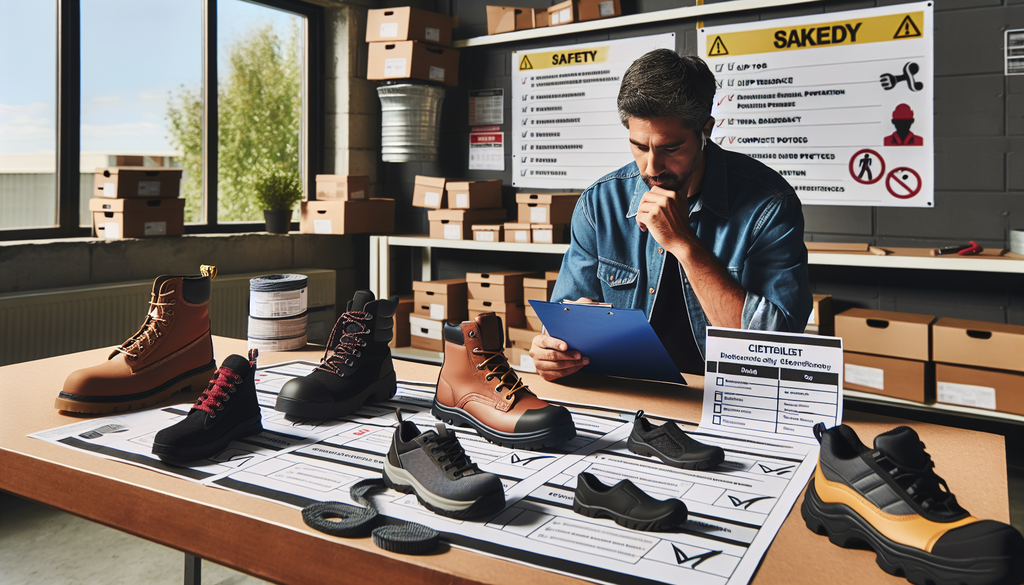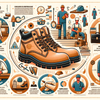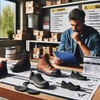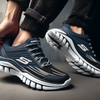How to Choose the Ideal Safety Footwear for Your Job

How to Choose the Ideal Safety Footwear for Your Job
Introduction:
Choosing the right safety footwear is essential to ensuring the protection and comfort of workers in a variety of work environments. With a wide range of options available on the market, it can be challenging to select the right footwear for each job. In this article, RAG Tailors, a specialist in professional clothing and uniforms, will guide you on how to choose the perfect safety footwear for your job, taking into account the specific risks, safety standards and comfort.
Index:
- Identifying risks in the workplace
- Safety standards and certifications
- Essential components of safety footwear
- Comfort and proper fit
- Types of safety footwear and their applications
- Safety footwear maintenance and care
- Frequently Asked Questions
1. Identifying risks in the work environment
Before choosing safety footwear, it is crucial to identify the specific risks present in the workplace. Each profession presents unique challenges, and safety footwear must be able to protect against these risks.
Some of the most common risks include:
- Impacts and crushing
- Drilling and cutting
- Slips and falls
- Exposure to chemicals
- Electric shocks
- Extreme temperatures
When assessing the work environment, consider factors such as the type of surface, the presence of heavy objects, exposure to liquids or chemicals, and weather conditions. This analysis will help you determine the type of protection needed in safety footwear.
2. Safety standards and certifications
Safety footwear must meet specific standards to ensure adequate protection. The most common standards are:
- EN ISO 20345: European standard for safety footwear
- ASTM F2413: American Standard for Protective Footwear
- CSA Z195: Canadian Standard for Protective Footwear
These standards set minimum requirements for resistance to impact, compression, puncture and other protective properties. When choosing safety footwear, check that it has the appropriate certification for your sector of activity.
Additionally, some work environments may require additional features such as anti-static protection, hydrocarbon resistance or electrical insulation. Be sure to check the specific requirements of your employer or industry before making your choice.
3. Essential components of safety footwear
Quality safety footwear consists of several elements that work together to provide protection and comfort. Essential components include:
-
Protective toe cap: Usually made of steel or composite, the toe cap protects the toes against impacts and crushing.
-
Anti-puncture insole: A puncture-resistant layer, usually made of steel or Kevlar, protects against sharp objects.
-
Non-slip sole: A specially designed sole with grippy material helps prevent slips and falls.
-
Breathable Lining: An air-permeable lining keeps feet cool and dry, reducing excessive sweating.
-
Shock Absorption System: A layer of cushioning in the sole or heel helps reduce fatigue and discomfort during long periods of standing.
When selecting safety footwear, check for these components and ensure they meet the safety standards relevant to your profession.
4. Comfort and proper fit
In addition to protection, comfort is a crucial factor when choosing safety footwear. Uncomfortable footwear can lead to fatigue, foot pain and reduced productivity. When trying on footwear, consider the following:
- Correct size: Make sure you choose the right size, allowing a little room for your fingers to move.
- Appropriate width: Make sure the width of the shoe fits your feet comfortably, without being too tight or too loose.
- Arch support: Good arch support can help reduce fatigue and improve posture.
- Cushioning: Adequate cushioning in the sole and heel can reduce impact and provide greater comfort during long periods of standing.
It is recommended to try on shoes at the end of the day, when your feet are naturally a little more swollen, to ensure a comfortable fit throughout your workday.
5. Types of safety footwear and their applications
There are several types of safety footwear, each designed to meet the specific needs of different professions. Some of the most common types include:
-
Safety boots: Ideal for work in construction, industry and agriculture, offering protection against impacts, punctures and chemical risks.
-
Safety shoes: Suitable for work in warehouses, logistics and light manufacturing, providing protection against impacts and slips.
-
Kitchen shoes: Designed for food professionals, with non-slip soles and resistance to oils and grease.
-
Anti-static footwear: Suitable for environments with a risk of electrostatic discharges, such as electronics or flammable product industries.
-
Insulating footwear: Used by electricians and professionals who work with high voltage, offering electrical insulation.
When selecting the type of safety footwear, consider the specific needs of your profession and work environment.
6. Maintenance and care of safety footwear
To ensure the durability and effectiveness of safety footwear, it is important to follow some maintenance and care practices:
-
Regular cleaning: Remove dirt and debris from shoes with a soft brush or damp cloth as needed.
-
Proper drying: After cleaning or exposure to moisture, let the shoes dry naturally in a ventilated place, away from direct heat sources.
-
Correct storage: Store shoes in a dry, airy place, avoiding direct exposure to sunlight or extreme temperatures.
-
Component Replacement: If the sole or other components show significant wear, consider replacing them to maintain adequate protection.
-
Regular inspection: Periodically check your shoes for damage, excessive wear or signs of deterioration, replacing them when necessary.
Following these maintenance practices can extend the life of your safety footwear and ensure that it continues to provide the protection you need.
Frequently Asked Questions
-
What are the main risks that safety footwear should protect against?
Safety footwear must protect against hazards such as impacts, crushing, punctures, slipping, exposure to chemicals, electrical shocks and extreme temperatures, depending on the specific work environment. -
How do I choose the right safety footwear for my type of work?
To choose the right safety footwear, you need to identify the specific hazards in your work environment, check applicable safety standards, and consider comfort and fit. Consult your employer or industry recommendations and try on different options to find the right footwear. -
What safety standards must footwear meet?
The main safety standards for footwear are EN ISO 20345 (European), ASTM F2413 (American) and CSA Z195 (Canadian). Check that the footwear you choose has the appropriate certification for your profession.
-
How important is comfort in safety footwear?
Comfort is essential in safety footwear, as uncomfortable footwear can cause fatigue, foot pain and reduced productivity. Choose a shoe with the right size and width, good arch support and cushioning to ensure comfort throughout the workday. -
How to identify the type of protection needed for different work environments?
To identify the type of protection needed, assess the specific hazards in your work environment, such as slippery surfaces, heavy objects, exposure to chemicals or electricity. Consult industry safety standards and employer recommendations to determine protective requirements. -
What are the essential components of safety footwear?
The essential components of safety footwear include a protective toe cap, anti-perforation insole, non-slip sole, breathable lining and shock absorption system. Make sure the footwear you choose has these elements and meets the relevant safety standards.
-
How to keep safety shoes in good condition?
To keep safety footwear in good condition, clean it regularly, allow it to dry naturally after exposure to moisture, store it in a dry, well-ventilated place, replace worn components when necessary, and inspect it periodically for damage or excessive wear. -
What are the most common types of safety footwear and their applications?
The most common types of safety footwear include safety boots (construction, industry, agriculture), safety shoes (warehouses, logistics, light manufacturing), kitchen shoes (food areas), anti-static footwear (environments with risk of electrostatic discharges) and insulating footwear (electricians, high voltage work). -
How to ensure safety footwear is the correct size?
To ensure you get the right size, try on your shoes at the end of the day, when your feet are naturally a little more swollen. Make sure there is enough room for your toes to move and that the width fits your feet comfortably, without being too tight or too loose.
-
What are the consequences of wearing inappropriate safety footwear?
Wearing inappropriate safety footwear can lead to foot injuries, fatigue, discomfort, reduced productivity and an increased risk of accidents. Furthermore, failure to comply with safety standards can result in legal sanctions for both the employer and the worker.
Conclusion:
Choosing the right safety footwear is essential to ensure the protection and comfort of workers in a variety of work environments. By considering specific risks, safety standards, essential components and proper fit, it is possible to select the perfect footwear for each job. RAG Tailors offers a wide range of safety footwear options, meeting the needs of different sectors. Invest in the safety and comfort of your feet by choosing the right safety footwear for your job.




